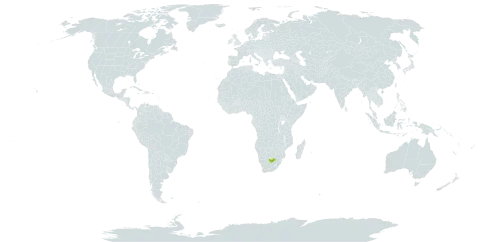Almost acaulescent, densely branched and compact shrub with at least partly subterranean stems and branches, glabrous except for leaf-axils and peduncle-bases; branches short and thick, leafy at the tips. Leaves crowded (almost rosulate) at the ends of the short young branches, suberect-erecto-patent, 1-5.5 cm long, pinnatipartite; coriaceous; rachis linear, flattened, towards the apex narrower and more filiform, 0.3-1.5 mm wide, distinctly or faintly midribbed; leaf-lobes 3-6 on each side, erecto-patent-spreading, linear-filiform, sub-opposite or alternate, 1-15 mm long, the middle ones the longest, ± straight and subrigid, acute with a firm whitish point; leaf-base dilated, 2-4 mm wide, (faintly) 5-veined, pilose-lanate in the axil. Peduncles terminal, solitary or a few together, erect, 5-20 cm long, 0.6-1.5(-2) mm thick, terete, finely striate-somewhat sulcate, arising from a tuft of wool. Involucre hemispherical-widely campanulate with flat-rounded base, 1-1.5 cm in diam. Involucral bracts 11-15, uniseriate, connate to slightly above the middle, distinctly 3-5-veined; the free lobes ovate-lanceolate, 2-4 mm long, 1.5-2.5 mm wide, acute, with ciliate-puberulous tips. Receptacle convex, distinctly alveolate. Ray-florets 8-10, yellow. Tube c. 2 mm long, cylindrical. Lamina narrowly elliptic-oblong-lorate, 9-11 mm long, 2-3 mm wide, 4-7-veined. Style terete with swollen base; style branches 0.7-1 mm long, obtuse. Disc-florets c. 40-70. Corolla 4.5-5 mm long. Tube c. 2 mm long, cylindrical, slightly widening towards the base. Limb campanulate, 2.5-3 mm long; lobes narrowly ovate-lanceolate, 1.2-1.8 mm long, c. 0.8 mm wide. Anthers 1.8-2 mm long incl. the oblong-ovate subacute appendage. Style terete-flattened with swollen base on a short stylophore; style branches 0.6-1 mm long, with truncate-slightly convex tips. Pappus bristles numerous-copious, 1-1.5 mm long, white, flexuous, densely barbellate-subplumose, ±erect, some sometimes reflexed. Achenes oblohg-obovate, 3-3.5 mm long, 1.5-2 mm wide, densely velutinous with short, brownish, ± spreading hairs (not mucilaginous when soaked), with 5-6 ribs under the indumentum.
More
Like E. mirus but leaves glabrous with linear-filiform lobes and disc florets fertile.
